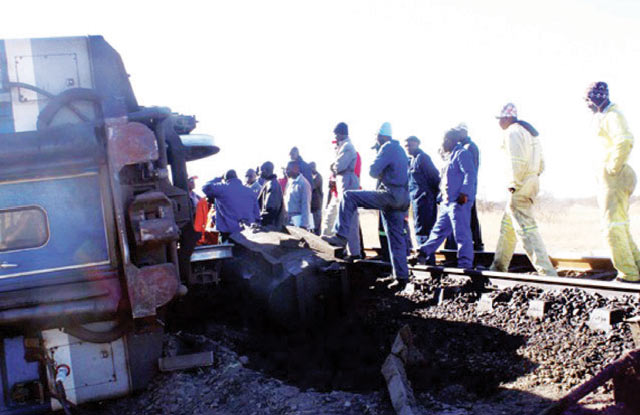Haulage truck menace

 Prosper Ndlovu
Prosper Ndlovu
“You need to be extra-cautious as a driver especially at night. Usually these truckers don’t dip their lights and this affects visibility. With the poor state of our roads there are high chances of hitting livestock or wild animals hence many drivers easily veer off the roads and find themselves in danger, DRIVING on Zimbabwe’s major highways has become a risky undertaking for most drivers given the high incidence of fatal accidents”
DRIVING on Zimbabwe’s major highways has become a risky undertaking for most drivers given the high incidence of fatal accidents.
The risk is much higher at night when the roads are littered with haulage trucks that ferry bulk goods between cities with some crossing the borders to neighbouring countries.
Melusi Sibanda (not his real name), who drives a delivery vehicle and has plied the Harare –Bulawayo-Victoria Falls route and Beitbridge-Masvingo-Harare routes, describes driving along the country’s major roads as a “frightening experience”.
“Daily we come across convoys of haulage trucks that move in groups of seven to 10. This puts drivers in an awkward situation especially on narrow roads where you risk a head-on collision each time you attempt to overtake,” he says.
On average Sibanda says on a single trip he comes across 100 local and foreign-owned haulage trucks carrying coal, cement and cement products, copper and other heavy commodities.
“You need to be extra-cautious as a driver especially at night. Usually these truckers don’t dip their lights and this affects visibility. With the poor state of our roads there are high chances of hitting livestock or wild animals hence many drivers easily veer off the roads and find themselves in danger,” says Sibanda.
“My company has suffered damages to windscreens on three vehicles from falling coal stones while overtaking or by-passing haulage trucks carrying coal. Some cause accidents due to panic.”
Sibanda’s experience mirrors the national concern on the spate of road carnage on the country’s highways where thousands of people die each year.
Experts have pointed to an urgent need for the widening of major roads, modernisation of the railway infrastructure for bulk transportation and establishment an efficient air transport network.
Economists place major focus on the speedy revitalisation of the ailing National Railways of Zimbabwe (NRZ) to fulfil its national mandate of bulk transportation. This comes from a realisation that the demise of the NRZ appears to have surrendered this strategic role to haulage truckers whose presence on the major highways has provoked a fierce national debate. Repeated concerns have been raised to the damage that heavy vehicles like haulage trucks inflict on the road infrastructure and their contribution to loss of life through accidents.
Addressing a recent Zim-Asset seminar in Bulawayo Vice President Phelekezela Mphoko was candid on his views about haulage trucks and the state of NRZ.
“Remove haulage trucks from our roads,” he said, “They’re causing a lot of damage and our people are dying due to accidents they cause”.
Economic analyst Reginald Shoko says reviving NRZ would remain a pipedream in the absence of a legislative framework that protects its business.
“NRZ used to perform well because bulk transportation was its preserve supported by law. Right now we’ve a problem repairing roads because we’ve too much heavy traffic on the roads,” he says.
“As long as ‘gonyets’ flood our roads the problem will continue. We need a legislative framework that supports NRZ business, to say for instance, any cargo that exceeds 20 tonnes should be transported by rail. This was the case before corrupt officials influenced a change in laws and put their trucks.”
Shoko said taking bulk transportation back to NRZ would not only protect the road infrastructure but also facilitate revival of Bulawayo industry and its downstream value chain.
Estimates indicate that the NRZ requires $400 million for its short-term recapitalisation, which will result in increased carrying capacity and production.
According to Saston Muzenda, a Ministry of Transport and Infrastructure Development director, NRZ’s capacity has been severely crippled due to reduction of moving wagons and old infrastructure.
The parastatal owns 168 locomotives, of which only 64 (38 percent) are currently serviceable while of the 7,255 wagons, only 3,467, which is 48 percent, are operational. “All the entity’s wagons have long gone beyond their design life of 40 years and the running fleet is also in a very poor state and most of the wagons are not fit to carry international traffic across the borders,” said Muzenda.
He said urgent recapitalisation was needed to procure 15 new locomotives, procure 1,000 new wagons and other equipment.
To increase capacity utilisation more investment is required in the infrastructure of NRZ. This will result in improved safety of train movements between sections as a result of stabilisation of communication and track infrastructure and an higher market share due to improved quality of service.
A revitalised NRZ will be able to increase earnings from operations, return to profitability and in turn be able to pay salaries and its debts.
Last week the Upper House debated this issue with senators expressing concern at the alarming number of road incidents on the country’s roads. They noted that most accidents are a result of dilapidated road infrastructure and faulty vehicles.
Mashonaland West Senator Mike Byton Musaka (Zanu-PF) drove the point home when he lamented “the deterioration of the railway system” in the country as well as the “lack of efficient and economic air transportation system”. “It has become almost a ritual that nearly every month there is a major road accident and the government declares a national disaster. This is not pleasing ,” said Musaka.
“The railways should be modernised to ensure that they are fast, affordable, accommodative and safe. The modernisation of railways would facilitate that three quarters of our traffic both passenger and goods is moved to the railway system. The railway system should also be geared towards carrying the bulk of the passengers. We need to look at the railway system for transportation of our goods instead of the roads.”
The House acknowledged the need to establish a special fund for upgrading and improving the transportation system in the country. Legislators stressed the need for the government to embark on a robust programme to modernise infrastructure programme for roads, air and railways, which is user friendly and accommodative of goods services and passengers at large. Such measures are expected to go a long way in reducing road carnage.









Comments